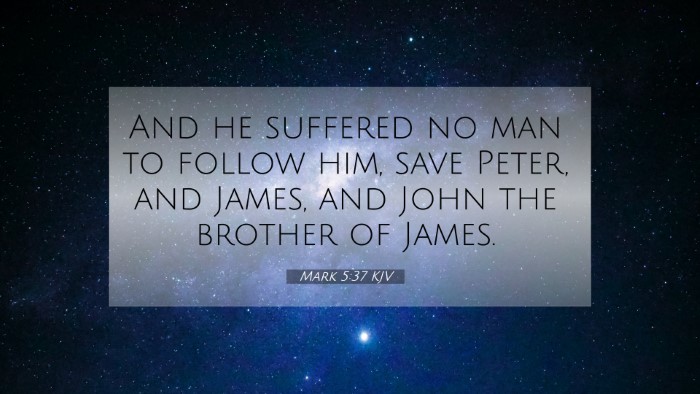Understanding Mark 5:37
In Mark 5:37, we see Jesus demonstrating a selective approach in His ministry. The verse states, "And He permitted no one to follow Him except Peter, James, and John the brother of James." This moment is significant, as it highlights the importance of inner circles in Jesus’ ministry, showcasing His unique relationship with His disciples.
Commentary Insights
This exploration pulls together insights from various public domain commentaries, including those by Matthew Henry, Albert Barnes, and Adam Clarke. Each commentator offers a unique perspective on the depth of this scripture, linking it to broader themes within the Bible.
Matthew Henry's Commentary
Matthew Henry emphasizes the particularity of Jesus' selection of these three disciples. He suggests that Peter, James, and John were chosen to witness some of the most profound moments of Christ’s earthly ministry, indicating a level of intimacy and trust. This selection underscores the reality of personal relationships within spiritual journeys, resonating with the idea that certain experiences are reserved for those closest to Christ.
Albert Barnes' Notes
Albert Barnes expands on the significance of this passage by noting that Jesus often retreated with His closest disciples. He explains that this act of selecting certain individuals hints at the formation of a more profound spiritual insight that they would receive. Barnes connects this to the notion that those who follow Jesus closely will understand His mission and works on a deeper level, thus emphasizing the value of dedicated discipleship.
Adam Clarke's Commentary
Adam Clarke provides a thorough analysis that aligns with the idea that Mark 5:37 presents a clear distinction between the multitudes and the chosen few. He notes that Jesus' actions in this verse reflect a methodical approach to ministry that prioritizes spiritual growth through personal connection. Clarke also suggests that the three disciples represent a blueprint for spiritual leadership, showing that effective ministry often springs from intimate relationships.
Cross-Referenced Insights
This verse connects with several thematic Bible verse connections, offering a richer understanding through cross-references. Below are 10 relevant Bible verses that relate closely to Mark 5:37:
- Matthew 17:1 - The Transfiguration; Jesus again took Peter, James, and John.
- Mark 14:33 - In Gethsemane, Jesus took these three disciples closer to Him.
- Luke 8:51 - This verse parallels Mark 5:37 in the context of the raising of Jairus’ daughter.
- John 20:2-10 - The post-resurrection appearances; Peter and John play crucial roles.
- 1 Corinthians 15:5 - References the apostles, emphasizing the role of key witnesses.
- Acts 3:1 - Peter and John healed a lame man, showing their continued importance.
- Galatians 2:9 - The "pillars" of the church mentioned, aligning with the discipleship model.
- Revelation 21:14 - The foundation of the New Jerusalem has references to the apostles.
- Isaiah 8:18 - The prophetic fulfillment of Jesus' inner circle as a sign of God's wonders.
- John 15:15 - Jesus speaks of His disciples as friends, indicating closeness and privilege.
Thematic Connections
Understanding Mark 5:37 through the lens of thematic Bible verse connections can enhance our interpretations. It leads us to explore concepts such as:
- Discipleship - The choice of Peter, James, and John symbolizes the depth of commitment required in following Christ.
- Leadership and Trust - Jesus intentionally invests in a select few, which teaches the principles of leadership in spiritual contexts.
- Your Inner Circle - Similar to how Jesus chose His disciples, individuals today should consider their own spiritual circles.
Practical Applications
When engaging with Mark 5:37, believers can draw practical applications for their lives:
- Evaluate your relationships - Who are the 'Peter, James, and John' in your spiritual life?
- Recognize the value of mentorship - Seek closer relationships that deepen understanding of God’s work.
- Encourage intimate worship - Foster environments where deeper spiritual connections can grow.
Conclusion
Mark 5:37 exemplifies the importance of selective discipleship and the transformational power of intimate spiritual relationships with the Savior. Through cross-referencing this verse with others and examining thematic connections, believers are invited to explore deeper meanings and applications in their own faith walk. Such a study combines structured tools for Bible cross-referencing with rich theological insights, making it a vital part of any serious Bible study.







